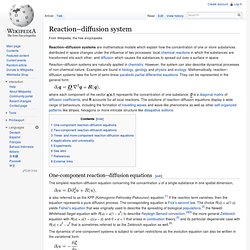

Wooj.files.wordpress.com/2012/11/gsd-fall-2012-04-reaction-diffusion-system.pdf. Java demo: Gray-Scott Reaction-Diffusion. Most of these images are linked to an applet with the same parameters so you can watch and interact with the pattern evolution.

Varying F, k, and diffusion parameters Parameters: F=0.035&k=0.065&diffuseU=0.16&diffuseV=0.08& simwidth=400&simheight=400& wrap=false&varyPhysics=true& diffuseU2=0.06&diffuseV2=0.03&F2=0.06&k2=0.062 This image shows how physical parameters can vary within a single environment. Here the diffusion constants vary on the vertical axis, and the reaction constants vary along the horizontal axis. Reaction–diffusion system. Reaction–diffusion systems are mathematical models which explain how the concentration of one or more substances distributed in space changes under the influence of two processes: local chemical reactions in which the substances are transformed into each other, and diffusion which causes the substances to spread out over a surface in space.

Reaction–diffusion systems are naturally applied in chemistry. However, the system can also describe dynamical processes of non-chemical nature. Examples are found in biology, geology and physics and ecology. Mathematically, reaction–diffusion systems take the form of semi-linear parabolic partial differential equations. They can be represented in the general form.